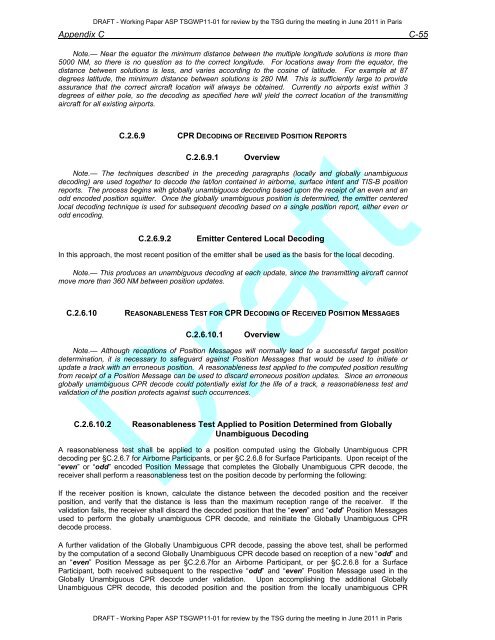Technical Provisions for Mode S Services and Extended Squitter
Technical Provisions for Mode S Services and Extended Squitter
Technical Provisions for Mode S Services and Extended Squitter
Create successful ePaper yourself
Turn your PDF publications into a flip-book with our unique Google optimized e-Paper software.
DRAFT - Working Paper ASP TSGWP11-01 <strong>for</strong> review by the TSG during the meeting in June 2011 in Paris<br />
Appendix C C-55<br />
Note.— Near the equator the minimum distance between the multiple longitude solutions is more than<br />
5000 NM, so there is no question as to the correct longitude. For locations away from the equator, the<br />
distance between solutions is less, <strong>and</strong> varies according to the cosine of latitude. For example at 87<br />
degrees latitude, the minimum distance between solutions is 280 NM. This is sufficiently large to provide<br />
assurance that the correct aircraft location will always be obtained. Currently no airports exist within 3<br />
degrees of either pole, so the decoding as specified here will yield the correct location of the transmitting<br />
aircraft <strong>for</strong> all existing airports.<br />
C.2.6.9 CPR DECODING OF RECEIVED POSITION REPORTS<br />
C.2.6.9.1 Overview<br />
Note.— The techniques described in the preceding paragraphs (locally <strong>and</strong> globally unambiguous<br />
decoding) are used together to decode the lat/lon contained in airborne, surface intent <strong>and</strong> TIS-B position<br />
reports. The process begins with globally unambiguous decoding based upon the receipt of an even <strong>and</strong> an<br />
odd encoded position squitter. Once the globally unambiguous position is determined, the emitter centered<br />
local decoding technique is used <strong>for</strong> subsequent decoding based on a single position report, either even or<br />
odd encoding.<br />
C.2.6.9.2 Emitter Centered Local Decoding<br />
In this approach, the most recent position of the emitter shall be used as the basis <strong>for</strong> the local decoding.<br />
Note.— This produces an unambiguous decoding at each update, since the transmitting aircraft cannot<br />
move more than 360 NM between position updates.<br />
C.2.6.10 REASONABLENESS TEST FOR CPR DECODING OF RECEIVED POSITION MESSAGES<br />
C.2.6.10.1 Overview<br />
Note.— Although receptions of Position Messages will normally lead to a successful target position<br />
determination, it is necessary to safeguard against Position Messages that would be used to initiate or<br />
update a track with an erroneous position. A reasonableness test applied to the computed position resulting<br />
from receipt of a Position Message can be used to discard erroneous position updates. Since an erroneous<br />
globally unambiguous CPR decode could potentially exist <strong>for</strong> the life of a track, a reasonableness test <strong>and</strong><br />
validation of the position protects against such occurrences.<br />
Draft<br />
C.2.6.10.2 Reasonableness Test Applied to Position Determined from Globally<br />
Unambiguous Decoding<br />
A reasonableness test shall be applied to a position computed using the Globally Unambiguous CPR<br />
decoding per §C.2.6.7 <strong>for</strong> Airborne Participants, or per §C.2.6.8 <strong>for</strong> Surface Participants. Upon receipt of the<br />
“even” or “odd” encoded Position Message that completes the Globally Unambiguous CPR decode, the<br />
receiver shall per<strong>for</strong>m a reasonableness test on the position decode by per<strong>for</strong>ming the following:<br />
If the receiver position is known, calculate the distance between the decoded position <strong>and</strong> the receiver<br />
position, <strong>and</strong> verify that the distance is less than the maximum reception range of the receiver. If the<br />
validation fails, the receiver shall discard the decoded position that the “even” <strong>and</strong> “odd” Position Messages<br />
used to per<strong>for</strong>m the globally unambiguous CPR decode, <strong>and</strong> reinitiate the Globally Unambiguous CPR<br />
decode process.<br />
A further validation of the Globally Unambiguous CPR decode, passing the above test, shall be per<strong>for</strong>med<br />
by the computation of a second Globally Unambiguous CPR decode based on reception of a new “odd” <strong>and</strong><br />
an “even” Position Message as per §C.2.6.7<strong>for</strong> an Airborne Participant, or per §C.2.6.8 <strong>for</strong> a Surface<br />
Participant, both received subsequent to the respective “odd” <strong>and</strong> “even” Position Message used in the<br />
Globally Unambiguous CPR decode under validation. Upon accomplishing the additional Globally<br />
Unambiguous CPR decode, this decoded position <strong>and</strong> the position from the locally unambiguous CPR<br />
DRAFT - Working Paper ASP TSGWP11-01 <strong>for</strong> review by the TSG during the meeting in June 2011 in Paris
















